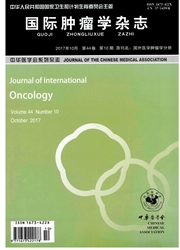

 中文摘要:
中文摘要:
背景研究证明了声音的刺猬小径的反常激活是仔细,与在中央紧张的 system.This 的 tumorigenesis 有关,学习试图调查在 brainstem 和 supratentorial glioma.Methods 的出现表明小径的声音的刺猬的角色实时量的反向的抄写聚合酶链反应( qRT-PCR )和 immunohistochemistry 习惯于在正常大脑织物的 5 个标本检测声音的刺猬相关的部件的表示, 10
 英文摘要:
英文摘要:
Background Studies have shown that abnormal activation of the sonic hedgehog pathway is closely related to tumorigenesis in central nervous system. This study aimed to investigate the role of the sonic hedgehog signaling pathway in the occurrence of brainstem and supratentorial glioma. Methods Real-time quantitative reverse transcription polymerase chain reaction (qRT-PCR) and immunohistochemistry were used to detect the expression of sonic hedgehog-related components in 5 specimens of normal brain tissue, 10 of grade II brainstem glioma, and 10 of grade II supratentorial glioma. The significance of differences between two groups was determined using the Mann-Whitney U test or the two-sample test according to the results of normality distribution tests. Results The mRNA expression levels of sonic hedgehog-related genes were higher in brainstem astrocytomas than in supratentorial astrocytomas and normal brain tissue. The level of protein patched homolog 1 (PTCH1) was significantly higher in brainstem astrocytomas than in supratentorial astrocytomas and normal brain tissue (P 〈0.01). Immunohistochemistry semi-quantitative analysis was consistent with the qRT-PCR result that PTCH1 expression was increased significantly in brainstem astrocytomas at the protein level (P 〈0.05). Conclusions Enhanced PTCH1 expression and activation of the sonic hedgehog pathway are involved in brainstem glioma. This may be related to the difference in malignant biological behavior between brainstem and hemispheric glioma and could be an ideal therapeutic target in brainstem glioma.
 同期刊论文项目
同期刊论文项目
 同项目期刊论文
同项目期刊论文
 期刊信息
期刊信息
